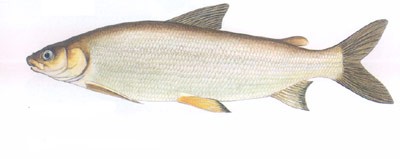Coregonus ussuriensis belongs to the order Salmoniformes, family Salmonidae, and genus Coregonus ussuriensis. Commonly known as: Yabasha, rabbit fish, white fish, big-eyed white fish. English name: Ussuri cisco.
Endangerment level: Vulnerable.
The body is long, oval, slightly flattened on the sides, the body height is greater than the head length; the head is small. The muzzle is short, about the same as the diameter of the eye. The mouth is located at the end of the mouth, with a small cleft; the maxilla is wide, the rear end is free, and the end reaches the bottom of the middle of the eyeball. The eyes have no fat eyelids, and there are no teeth on the upper and lower jaws, vomer, palatine and tongue. Each fin is small; the caudal fin is deeply forked; it has a very small adipose fin. The body scales are larger and the lateral line is straight, with 86-92 lateral line scales. Tail peduncle short. The back of the body is gray green, and the sides and abdomen are silvery white. The dorsal fin, adipose fin and caudal fin are slightly light yellow, and the pectoral fin, pelvic fin and anal fin are grayish yellow.

Ussuri whitefish is a northern cold-water fish. It likes to inhabit plain rivers or mountain streams with clear water, gravel or gravel bottoms, and low water temperatures, or hide in deep waters of large rivers. It is a land-sealed type. They often live in waters with a water temperature of 1-20°C. The optimal water temperature is about 10°C, but they can still eat normally when the water temperature drops to 1°C. As the environmental temperature of living waters changes, there is an obvious seasonal migration: from April to May, the river thaws and after the running period ends, they cluster in the shallow water areas of the river to search for erbium; when the water temperature rises above 15°C, they begin to swim upstream where the water temperature is lower. Tributaries or mountain streams; in October, when the water temperature drops below 10°C, they swim back to the original river tributaries to breed. Overwinter in deep river channels. Ussuri whitefish are carnivorous fish and mainly feed on small fish, crustaceans, aquatic insects, etc. Eating is almost stopped in summer, and appetite is stronger in spring and autumn. The growth rate is slow. The length of fish in the fifth year is about 31.5 cm, in the sixth year it is 36.4 cm, and in the seventh year it is 40.7 cm. An individual with a body length of 35 cm weighs about 0.5 kg. Sexual maturity takes 5-6 years, and the spawning period is from late October to early November. The spawning site is chosen in a tributary.
Ussuri whitefish is mainly produced in the Ussuri River in Heilongjiang Province, followed by Heilongjiang, Songhua River, Xingkai Lake and other waters, with a smaller number in the Nen River. In addition to the Heilongjiang water system in Russia, it is also distributed in Sakhalin Island abroad.
Ussuri whitefish is the main economic fish in Heilongjiang Province and is also a specialty fish in Heilongjiang Province. The production is mostly in the Ussuri River, the lower reaches of the Songhua River, and the middle reaches of the Heilongjiang River. At present, the annual output of Heilongjiang Province is about 50 tons, accounting for 0.4% of the total catch; in the lower reaches of Heilongjiang in Russia, it reached approximately 116.2-640.6 tons in 1940. But now the output is significantly reduced. The meat is tender and delicious, and the fat content is as high as 7-16%. Ussuri whitefish can be stocked in northern valley-type reservoirs.
Since the main production areas are located in the border river between China and Russia, and there are no restrictions on the production of the border river, overfishing, especially the large number of juvenile fish weighing 100-200 grams by Chinese and Russian fishermen, directly affects the normal replenishment of resources. Furthermore, the pollution of the living water environment also affects the normal life activities of fish. In recent years, large and elderly fish have become extremely rare.
animal tags:
We created this article in conjunction with AI technology, then made sure it was fact-checked and edited by a Animals Top editor.